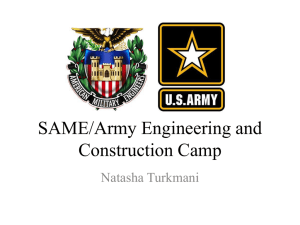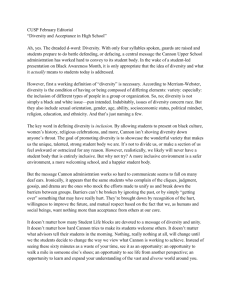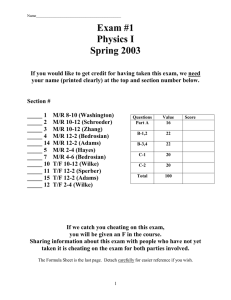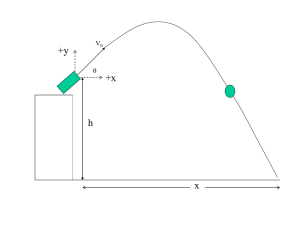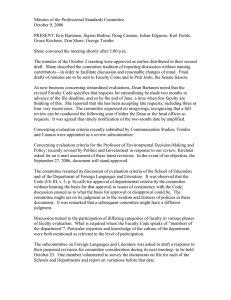Exam #1 Physics I Fall 2006
advertisement
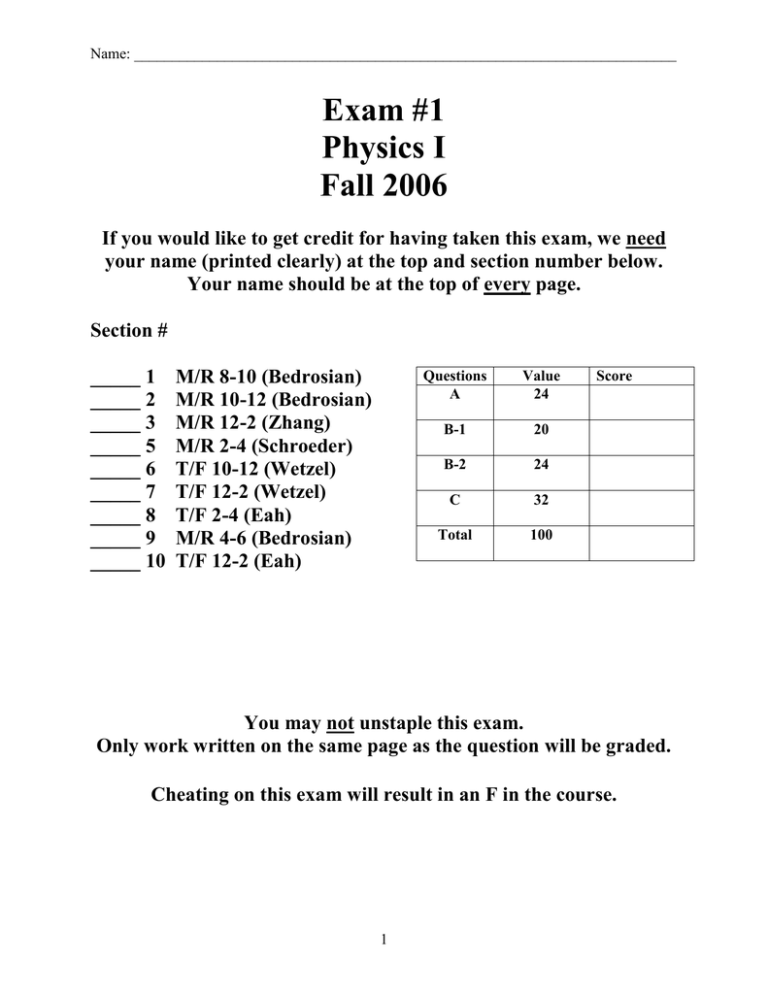
Name: ________________________________________________________________________ Exam #1 Physics I Fall 2006 If you would like to get credit for having taken this exam, we need your name (printed clearly) at the top and section number below. Your name should be at the top of every page. Section # _____ 1 _____ 2 _____ 3 _____ 5 _____ 6 _____ 7 _____ 8 _____ 9 _____ 10 M/R 8-10 (Bedrosian) M/R 10-12 (Bedrosian) M/R 12-2 (Zhang) M/R 2-4 (Schroeder) T/F 10-12 (Wetzel) T/F 12-2 (Wetzel) T/F 2-4 (Eah) M/R 4-6 (Bedrosian) T/F 12-2 (Eah) Questions A Value 24 B-1 20 B-2 24 C 32 Total 100 Score You may not unstaple this exam. Only work written on the same page as the question will be graded. Cheating on this exam will result in an F in the course. 1 Name: ________________________________________________________________________ On this exam, please neglect any relativistic and/or quantum mechanical effects. If you don’t know what those are, don’t worry, we are neglecting them! On all multiple-choice questions, choose the best answer(s) in the context of what we have learned in Physics I. On graphing and numerical questions (Parts B and C), show all work to receive credit. Part A – Multiple Choice – 24 Points Total (6 at 4 Points Each) Write your choice(s) on the line to the left of the question number. Questions 1-3 refer to the figure below. Two masses hang from ideal massless strings connected via ideal massless pulleys to a third mass sliding on a horizontal, frictionless surface. The acceleration constant of gravity is g. The weights of each mass are as follows: m1 g = 6 N, m2 g = 12 N, m3 g = 18 N. T1 m3 T2 m1 m2 gravity _______1. A) B) C) D) g/12 g/8 g/6 g/5 _______2. A) B) C) D) 4N 5N 6N 7N _______3. A) B) C) D) 4N 5N 6N 7N What is the magnitude of the acceleration of mass 3? E) F) G) H) g/4 g/3 g/2 g What is the tension, T1, in the string connected to mass 1? E) F) G) H) 8N 9N 10 N 12 N What is the tension, T2, in the string connected to mass 2? E) F) G) H) 8N 9N 10 N 12 N 2 Name: ________________________________________________________________________ Questions 4-6 refer to the figure below. Two cannons on a horizontal plane, A and B, fire their respective cannon balls so that the two cannon balls collide at the maximum height, which is the same for both cannon balls. The cannon balls explode into a total of 20 separate pieces due to internal forces. Assume the cannon balls are fired from the same height above the ground. Neglect air resistance and do not assume that the cannons or cannon balls are identical. Y X A _______4. A) B) C) D) B gravity Which cannon should be fired first so that the cannon balls collide? Cannon A. Cannon B. Both should be fired at the same instant. There is not enough information given to determine which should be fired first. For Questions 5 and 6, consider the system consisting of the two cannon balls (or the 20 pieces) in the time interval after both cannon balls have been fired but before the pieces hit the ground. _______5. A) B) C) D) X only. Y only. Both X and Y. Neither X nor Y. _______6. A) B) C) D) In which direction(s) is the momentum of the system conserved? In which direction(s) is the velocity of the center of mass constant? X only. Y only. Both X and Y. Neither X nor Y. 3 Name: ________________________________________________________________________ B-1 – Graphing – 20 Points This question involves one-dimensional motion. A cart on a long track begins at rest and is subject to the net force shown below, over the time interval (0,6) seconds. Plot the resulting momentum of the cart (p) over the (0,6) second time interval. Make sure to include the following features – they should be clearly shown on your graphs: 1. Clearly labeled vertical axis with values and units. 2. General shapes of the curves, noting any points where the curvature or slope changes. 3. The values of p at t = 0, 2, 4, and 6 seconds. Show all work. Fnet (N) 1 0 t (sec) 2 4 6 -1 p( ) 0 t (sec) 2 4 6 4 Name: ________________________________________________________________________ B-2 – Graphing – 24 Points Puck A, mass 0.30 kg, sliding on frictionless ice in the XY plane, hits Puck B, mass 0.60 kg, which is a rest before the collision. No significant external forces act on the two-puck system in the X or Y directions. Graphs of the velocity of Puck A versus time are given. Plot the X and Y velocity graphs for Puck B. Make sure to include the following features – they should be clearly shown on your graphs: 1. Clearly labeled vertical axis with values and units. 2. General shapes of the curves, noting any points where the curvature or slope changes. 3. The values of X and Y velocity at t = 0, 0.2, 1.0, 1.4, and 2.0 milliseconds (msec). Show all work. VAx (m/s) VAy (m/s) 4 4 2 2 0 t (msec) 1.0 0 2.0 t (msec) 1.0 -2 2.0 -2 VBx (m/s) VBy (m/s) t (msec) 0 1.0 t (msec) 0 2.0 1.0 5 2.0 Name: ________________________________________________________________________ Problem C (32 Points) – Target Practice A cannon with a fixed launch angle of 18.435° above horizontal must hit a target that is dropped from rest by helicopter. The target’s initial position is a horizontal distance (X) of 1500.0 m and a vertical distance (Y) of 1112.5 m from the initial position of the cannon ball. (See the figure.) The initial speed of the cannon ball as it leaves the cannon is 158.11 m/s. Use g = 9.8000 m/s and neglect air resistance. In order to hit the target, the cannon ball must be within 0.1 m of it. Show that the cannon ball will hit the target if the cannon is fired 5.0000 seconds after the target is dropped. On your way to showing this, find the initial velocity of the cannon ball at the firing time, and the time (measured starting from the target drop) of the collision. target dropped at t = 0.000 sec Y h = 1112.5 m X cannon fired at t = 5.000 sec = 18.435° d = 1500.0 m (Show additional work on the next page if you need more space.) Initial X velocity of cannon ball = ______________________________________________ m/s Initial Y velocity of cannon ball = ______________________________________________ m/s Time of collision with the target = ______________________________________________ s 6 Name: ________________________________________________________________________ This page is for additional work on problem C if you need it. Don't put work for Part B here please. 7 Name: ________________________________________________________________________ Formula Sheet for Homework and Exams – Page 1 of 2 U Fcons dx 1. v v 0 a t t 0 23. 2. x x 0 v 0 ( t t 0 ) 12 a ( t t 0 ) 2 24. U g m g (y y 0 ) 3. x x 0 12 ( v0 v)( t t 0 ) 25. U s 12 k ( x x 0 ) 2 4. x x 0 v( t t 0 ) 12 a ( t t 0 ) 2 26. 27. 28. K U Wnoncons s r v tangential r 29. a tangential r 6. v 2 v 02 2a x x 0 F Fnet m a 7. T 8. a centripetal 5. 9. 10. 11. 12. 13. 14. 15. 16. 17. 18. 19. 20. 2r v v2 2 r r a radial a centripetal p mv dp F F net dt J Fnet dt p P pi dP Fext dt 30. 0 t t 0 31. 0 0 ( t t 0 ) 12 ( t t 0 ) 2 32. 0 12 (0 )( t t 0 ) 33. 0 ( t t 0 ) 12 ( t t 0 ) 2 2 02 2 0 35a. a b a b sin( ) a b a y b z a z b y î 35b. a z b x a x b z ĵ a x b y a y b x k̂ 34. 36. 37. M mi 38. 1 1 x cm m i x i y cm m i y i M M P M v cm a b a b cos() a x b x a y b y a z b z W Fd W F dx 21. K 12 m v 2 12 m (v x v y ) 22. K f K i Wnet 2 39. 40. 41. 42. 43. 2 I m i ri 2 K rot 12 I 2 W d r F dL I d t l r p L l i L I 44x. m1 v1, x ,before m 2 v 2, x ,before m1 v1, x ,after m 2 v 2, x ,after 44y. m1 v1, y ,before m 2 v 2, y ,before m1 v1, y ,after m 2 v 2, y,after 44z. m1 v1,z ,before m 2 v 2,z ,before m1 v1,z ,after m 2 v 2,z ,after 45a. v1,f m1 m 2 2 m2 v1,i v 2 ,i m1 m 2 m1 m 2 45b. 8 v 2,f 2 m1 m m1 v1,i 2 v 2 ,i m1 m 2 m1 m 2 Formula Sheet for Homework and Exams – Page 2 of 2 46a. 46b. 47a. 47b. 48a. 48b. 49. m m | F | G 1 2 2 r m m F G 1 2 2 r̂ r 1 | q1 || q 2 | | F | 4 0 r2 1 q1 q 2 F (r̂ ) 4 0 r 2 1 | qi | | Ei | 4 0 ri 2 1 qi E (r̂i ) 4 0 ri 2 F qE 50. 51. 52. 1 qi 4 0 ri U qV V E dx V V x V 53y. E y y V 53z. E z z 54. F q v B mv 55. r qB 53x. E x Useful Constants (You can use the approximate values on exams.) Universal Gravitation Constant G 6.67310 11 N m 2 kg 2 6.67 10 11 Electrostatic Force Constant 1 8.987551788 10 9 N m 2 C 2 9.0 10 9 4 0 Magnetic Constant 0 4 10 7 H m 1 1.26 10 6 Speed of Light in Vacuum c 2.99792458 10 8 m s 1 3.0 10 8 Charge of a Proton e 1.602176462 10 19 C 1.6 10 19 Electron-Volt Conversion Constant 1eV 1.602176462 10 19 J 1.6 10 19 Mass of a Proton m p 1.6726215810 27 kg 1.67 10 27 Mass of an Electron m e 9.10938188 10 31 kg 9.110 31 9

